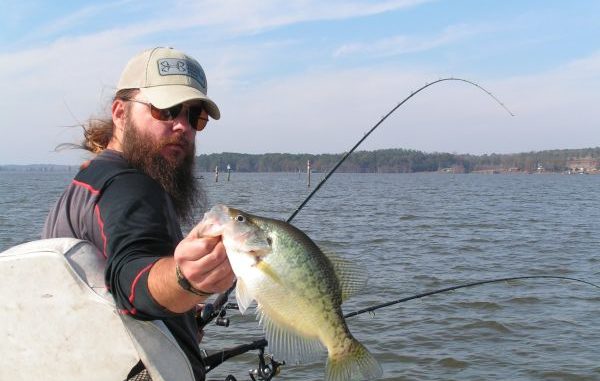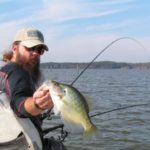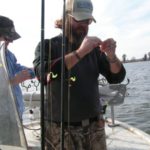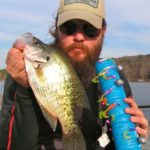
During the transition to the spawn, there are still plenty crappie in deep channels. And this Duck Commander crew member has developed a rig that loads the boat.
“That’s not a fair question,” Jay Stone said, turning his head quickly to eyeball the tip of one of the 16-foot crappie poles that he thought had signaled another fish on the end of the line.
The question seemed simple enough: “Would you rather go crappie fishing or duck hunting?”
Stone is the production manager for duck calls at West Monroe’s Duck Commander and a member of the famous first family of ducks. Among other things, his job required him overseeing the production of more than 1 million calls the year before last and nearly that many last year.
“OK, I guess I’d have to say duck hunting —but only because it’s part of my job,” he said.
Then he thought a minute.
“No, that’s not it,” he admitted. “The answer is duck hunting in the morning and crappie fishing in the afternoon.”
It didn’t take long in the boat this day with Stone and his first mate “Slim,” also a duck shop crew member, to show how serious they were about catching crappie. They rigged up 10 Duck Commander trolling and double-touch rods with 4-foot-long jig rigs that had been carefully wrapped in sequence around 1-foot sections of Styrofoam swim floats and attached one to each rod.
Before you could say “get the net,” the boat was trolling at a controlled speed into the wind straight down the middle of the old river channel on Lake D’Arbonne in search of suspended crappie.
Ten poles. Four curly-tail plastic jigs and a 2-ounce bell weight on each. Trolling at .8 to 1.1 mph fishing 16 to 20 feet deep over suspended crappie shown flashing on the boat’s depth finder.
Welcome to power trolling for stone cold crappie.
And may we introduce you to the Kitchen Sink? And believe it or not, the multiple rigs even showed up on the electronics.
“Some people call this pushing or pulling, but it’s simply trolling at just the right speed to make the curly tails come to life yet keep them at the proper depth,” Stone said. “As for the lure setup, you always hear people say they throw everything at them but the kitchen sink.
“Well, I call this the kitchen sink.”
There’s no question about it: With this kind of fishing, it’s usually a reaction bite, Stone said.
Stone has only been fishing for crappie for about 10 years, but he’s gone into it with eyes (and throttle) wide open.
His philosophy: Go big or go home.
“If I’m going to be a bear, then I might as well be a grizzly,” Stone said. “Either go big or go home. Some people don’t like spider rigging and don’t like multiple baits on the line at one time, but I say the more baits you’ve got in the water the more chance you have of catching a fish.
“It does get kind of hectic when you hit a school of hungry crappie, but that’s what makes it worth all the effort. It borders on going from fun to work, but when you catch crappie — no matter how you do it — it’s always fun.”
This time of year is a transition period for crappie all around the state. While some of the fish have already moved shallow, many others are still holding in the river channels or in deeper sloughs and creek channels that allow trolling with multiple baits.
That’s why Stone and his fishing partners, who also include Duck Dynasty stars John Godwin and Martin (yes, he has a first name: Justin) frequent area lakes like D’Arbonne and Claiborne as well as the deeper Ouachita River lakes and creeks this time of year when their busy schedules will allow.
OK, back to the kitchen sink.
“A friend of mine, Clark Laborde of West Monroe, does a lot of long lining,” Stone said. “He taught us a lot about crappie fishing. He catches them on heavy jigheads and curly tail plastics. It takes a lot of skill to do that, and he usually fishes over or around structure. It’s the kind of fishing where you troll slowly, but if you stop you can get hung up a lot.
“One night I was laying there trying to go to sleep when I thought about this idea. I thought about those good pro crappie fishermen who push crankbaits and use big weights to hold them down. And I thought about what Clark does. So I tried to one-up them a bit and I came up with the kitchen sink.”
Huh?
“It is basically a series of four 1/16-ounce lead-head jigs with a curly tail plastic jig on each one,” he explained. “I tie three jigs about 1 1/2 feet apart then a 2-ounce bell sinker trailed with one more jig on the bottom.
“It allows you to cover 5 feet of the water column, and when fish are suspended you don’t have to hit the exact depth — you have some flexibility in getting the lure in front of them. All of them aren’t at the same depth, either, so that’s an advantage.”
The trolling speed is important for two reasons. First, you want to go between. .8 and 1.1 mph because it is at that speed that the curly tails work best.
It also keeps the bait down at the proper depth all the time.
Good electronics help measure that speed.
“With these rigs, I’ve got 10 times more baits in the water than folks with single jig poles, and when I pay attention I can actually turn in the channel and not have to worry about the baits going to the bottom or hanging up,” Stone said. “It is a technique for open water —mMake no mistake about that.
“If you get out of the channel, it turns from the kitchen sink to the cussin’ fit rig in a hurry.”
Like many crappie fishermen, Stone is a former bass-fishing addict. He also likes to cook and eat. In fact, it was his cooking that got the former coach and teacher’s foot in the door that led to his marriage to Al’s daughter (and Phil’s oldest granddaughter) Anna.
It was also that love of good eating that got him chasing crappie.
“One night Godwin and I were at someone’s house, and they fried up a mess of crappie filets,” Stone said. “When we ate them, we turned to each other and wondered why we were wasting time catching and eating bass.”
That led them to learn more about how to catch crappie.
“We used to think the only way to catch crappie was when the moved shallow in the spring, using a pole, a minnow and a cork,” Stone said. “We did a little investigating and have kept our eyes open, and now catch crappie with a variety of lures and techinques.”
Of course, his favorite is the kitchen sink in deep water.
“It won’t be long until we have to put this down and go shallow, but as long as there are fish deep we’ll be giving them an opportunity to bite this rig,” Stone said. “It’s just the right thing to do.”





